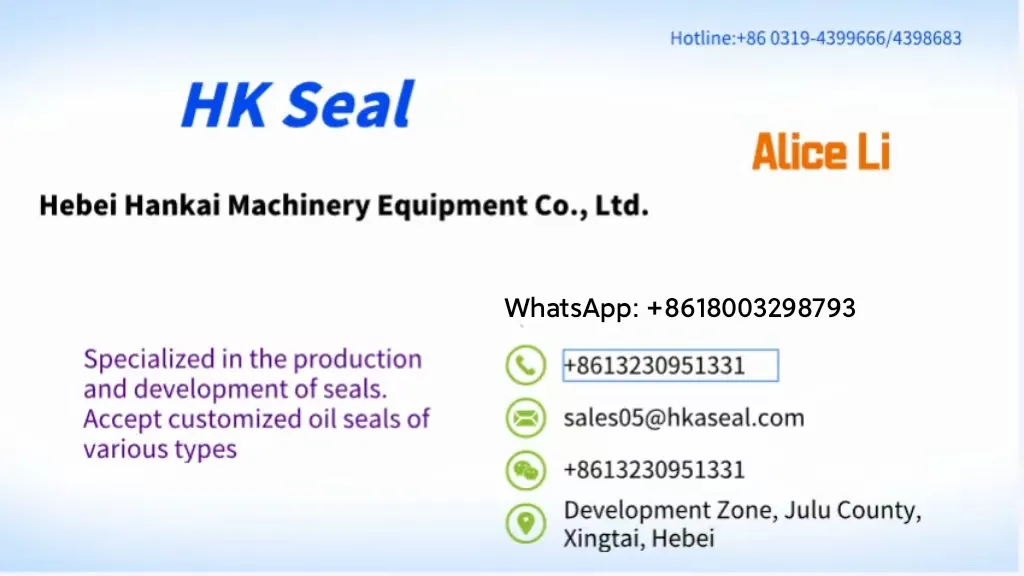Sep . 06, 2024 04:56 Back to list
Comprehensive Guide to Hydraulic Oil Seal Types
Understanding Hydraulic Oil Seal Types
Hydraulic systems play a vital role in various industrial applications, from manufacturing to automotive engineering. At the core of these systems are hydraulic oil seals, which are crucial for ensuring the efficiency and longevity of hydraulic machinery. The primary function of a hydraulic oil seal is to prevent the leakage of hydraulic fluid while keeping contaminants out of the system. This article aims to explore the different types of hydraulic oil seals, their applications, and their significance in hydraulic systems.
Types of Hydraulic Oil Seals
1. Dynamic Seals These seals are used in moving components, where relative motion exists between the sealing surfaces. Dynamic seals are often made of elastomers or thermoplastics, providing flexibility and a tight fit to minimize leakage. Common dynamic seals include rotary shaft seals and lip seals, which are used in hydraulic pumps, motors, and actuators.
Understanding Hydraulic Oil Seal Types
3. O-rings O-rings are one of the most widely used sealing solutions in hydraulic systems. They are circular rings that fit into a groove between two surfaces. When compressed, O-rings create a tight seal that prevents fluid leakage. Their versatility and ease of installation make them suitable for various applications, from small hydraulic circuits to large machinery.
hydraulic oil seal types

4. Quad Rings Similar to O-rings, quad rings have a unique four-lobed design, which offers an increased sealing surface area. This design allows quad rings to maintain their position better during application, reducing the risk of extrusion and enhancing sealing performance under high pressure. They are particularly effective in high-temperature and high-pressure environments.
5. Lip Seals These seals consist of a flexible lip that presses against the shaft surface to provide a barrier against leakage. Lip seals are favored for their durability and ability to handle a wider range of operating conditions. They are commonly found in hydraulic cylinders, where they maintain pressure and prevent contamination.
6. Wiper Seals Also known as dirt seals, wiper seals are used to prevent dirt and debris from entering the hydraulic system. These seals are typically placed at the rod end of hydraulic cylinders and work by wiping the rod as it retracts. Maintaining cleanliness is essential for the longevity of hydraulic components, and wiper seals play a crucial role in this aspect.
Conclusion
Choosing the right type of hydraulic oil seal is essential for optimizing the performance and reliability of hydraulic systems. Understanding the different seal types, their applications, and their construction materials can help engineers and technicians make informed decisions. Properly installed and maintained hydraulic oil seals not only prevent leaks but also contribute to the overall efficiency and durability of hydraulic machinery. As industries continue to evolve, the development of advanced sealing technologies will play a significant role in enhancing hydraulic system performance.
-
TCN Oil Seal Metal Ring Reinforcement for Heavy Machinery
NewsJul.25,2025
-
Rotary Lip Seal Spring-Loaded Design for High-Speed Applications
NewsJul.25,2025
-
Hydraulic Cylinder Seals Polyurethane Material for High-Impact Jobs
NewsJul.25,2025
-
High Pressure Oil Seal Polyurethane Coating Wear Resistance
NewsJul.25,2025
-
Dust Proof Seal Double Lip Design for Construction Equipment
NewsJul.25,2025
-
Hub Seal Polyurethane Wear Resistance in Agricultural Vehicles
NewsJul.25,2025
-
The Trans-formative Journey of Wheel Hub Oil Seals
NewsJun.06,2025
Products categories
















